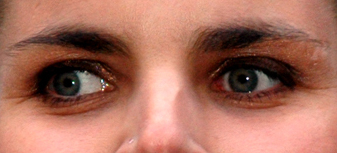 |
| Studying the short- and long-term effects of myopia management strategies on patients with strabismus can better evaluate the risks and benefits of such interventions in specific populations. Photo: Ivana Štenclová/Wikimedia Commons. Click image to enlarge. |
The changing trends of myopia management demonstrate the need to study how the natural course of its progression differs among different patient groups. Researchers from the Cleveland Clinic felt an updated investigation on its possible correlation with intermittent exotropia was warranted. Their study, published in Optometry and Vision Science, used a large retrospective cohort to examine myopic progression in patients with and without intermittent exotropia and found no difference in natural myopia progression among the two groups. However, the team noted a trend towards significance in the reduction of progression with strabismus correction surgery.
This study analyzed a retrospective cohort of 1,239 pediatric myopic patients. The average age at initial presentation was 8.74, and patients were followed up for an average of 1.98 years. The average baseline spherical equivalent in this population was -1.13D and the median of the mean annualized spherical equivalent change was –0.41D per year among the two groups.
In this cohort, 275 (22%) of myopic patients were identified to have a concurrent diagnosis of intermittent exotropia and 12 (4.4%) of this group underwent surgical correction in the study period. The researchers did not identify any statistically significant difference in myopic progression between those with intermittent exotropia and those without strabismus or any difference in mean annual spherical equivalent change between intermittent exotropia patients who did not undergo surgery compared with those who did.
Intermittent exotropia has previously been hypothesized to cause myopia progression due to increased accommodative demand—or vice versa, in which myopia lends to lower accommodative demand, resulting in reduced convergence and therefore the development of intermittent exotropia. Many believe that this phenomenon suggests that either correction of intermittent exotropia may slow progression of myopia or correcting myopia may reduce risk of intermittent exotropia.
The researchers proposed that a larger sample size for both patients who underwent myopia treatment and those whose strabismus was surgically corrected may be able to further elucidate their effects on myopia and that future research analyzing the long-term interplay between myopia and strabismus may yield clinically significant effects not captured in their study.
“Improved understanding of how myopia behaves in strabismic vs. non-strabismic patients will positively impact patient care by guiding treatment decisions and ultimately reducing cost, limiting potential exposure to adverse effects and improving outcomes,” the authors wrote in their paper.
Kim S, Babiuch A, Xiao H, Williamson A. Comparison of myopia progression among myopic children with intermittent exotropia and no strabismus. Optom Vis Sci. August 7, 2023. [Epub ahead of print]. |

